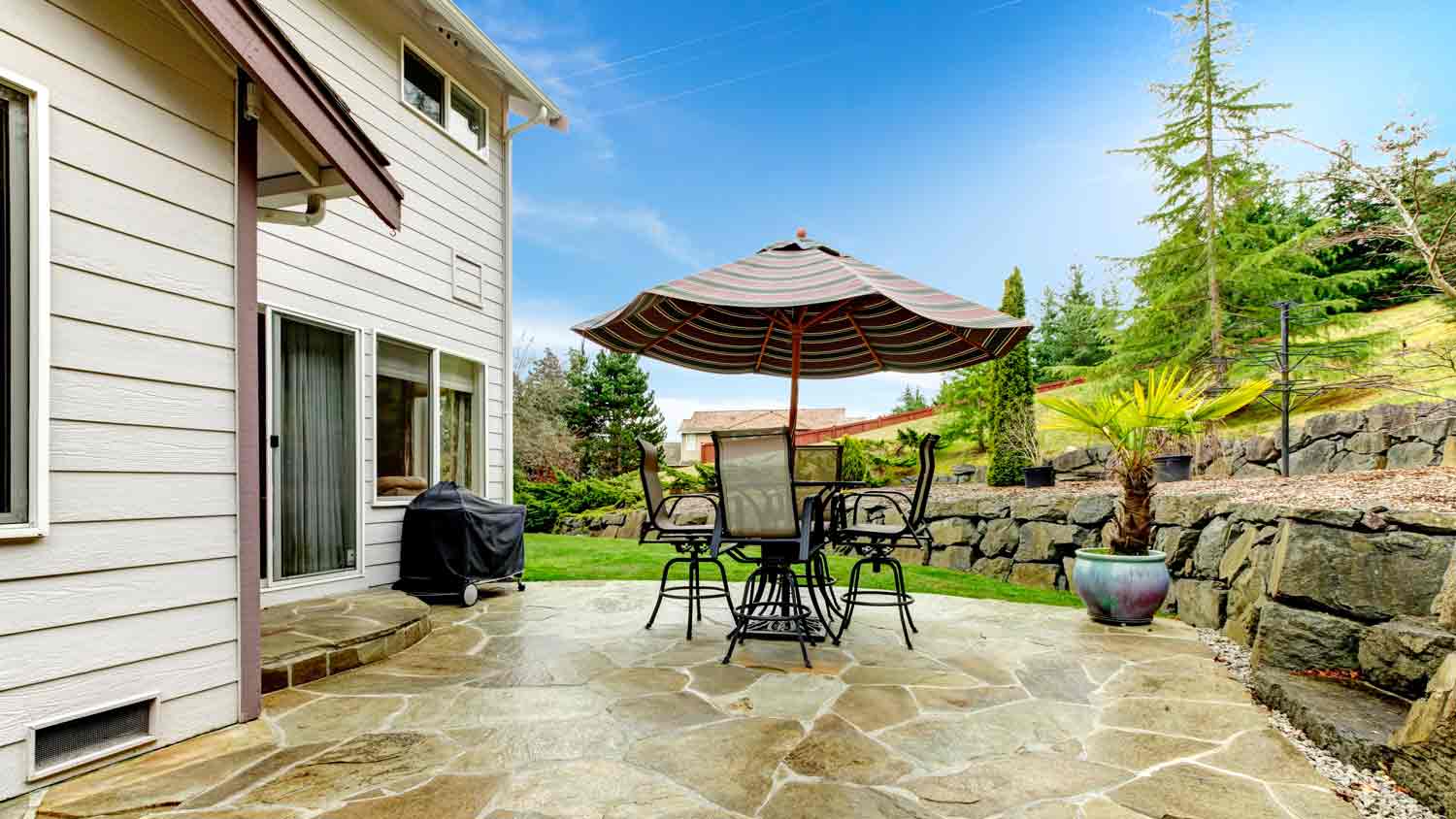
From patios and gazebos to full-on structures, your outdoor space is a blank slate. Learn how much it costs to build and furnish an outdoor room.
Don’t crack under the pressure of your patio damage


Cracks in a concrete patio may be caused by settlement, heave, spalling, or poor installation techniques.
Other potential causes include erosion, damage from tree roots, and foundation damage to the home.
DIYers can fill minor cracks with epoxy, but larger or more widespread cracks require professional work.
A cracked patio not only looks bad, but it can also lead to structural damage. With the average cost to install a patio at $4,000, the last thing you want is to pay for expensive repairs on top of that initial cost. This guide covers the most common causes of a concrete patio cracking and offers solutions to fix each one.
It’s natural for concrete to settle slightly after installation. But if the slab settles unevenly, excessive pressure across the patio slab can cause cracking. Minor settlement cracks are cosmetic, but larger or wider cracks could signal a structural issue.
There are two solutions to this issue: Remove the patio and install a new one, or correct the slope beneath the concrete slab by injecting polyurethane foam. You can fill minor cracks with epoxy.

While settlement causes the patio to sink in places, heaving causes it to rise. Concrete heave is caused by the expansion of soil underneath the patio due to water retention or frost, which places excessive pressure on the patio, causing cracks to develop.
Correct the drainage around your patio to prevent water from collecting underneath it. Depending on the severity of the issue, you may need to install downspout extensions or require a new yard drainage system to direct water away from the patio.
Concrete spalling occurs due to natural weathering or chemical reactions. In turn, spalling causes the concrete patio to develop cracks or chipped areas.
You can repair minor spalling with epoxy. However, if the issue is significant, you may need a new patio installed.
If your concrete patio wasn’t installed correctly, it is likely to develop cracks. For example, a poor mud mixture containing too much water can make the patio weaker and cause cracks. The cracks could also develop due to insufficient curing.
When building a new concrete patio, hire a pro to ensure proper installation. If your newly installed patio starts to crack, check your contract for a warranty and call the installer to fix the issue.
Soil erosion is a natural process, but if the earth under your patio experiences excessive erosion, you may notice cracks appearing. Erosion causes air pockets beneath the concrete slab, creating uneven pressure.
Compacting the soil before installing the patio can help prevent erosion, and installing a better drainage system can also help. However, if the contractor didn’t properly address these issues when installing the concrete, you may need to replace your patio.

Tree roots can cause cracks in a concrete patio if they begin growing underneath the slab. If left untreated, the tree roots will continue to grow, as will the cracks. The concrete may also lift in certain areas.
Cut down any trees that are too close to the patio. When installing a new concrete patio, choose an area away from trees to prevent future root damage.
If your patio connects to your home’s foundation, the underlying cause of cracks could be foundation damage. This is a serious issue that can cause extensive structural damage to your home.
Contact a foundation repair professional near you to inspect the foundation and provide recommendations on how to address the issue.
A homeowner can easily fix minor cracks in a concrete patio with some epoxy. However, for more severe cracks that cause the patio to become uneven, it’s best to hire a concrete patio or deck repair professional near you. A pro can pinpoint the cause of your patio cracks and explain the best steps to address the issue.
Prevention is key when it comes to concrete patio cracks. Take the following steps to prevent concrete cracks in the first place.
Mix the concrete properly: Adding extra water to the concrete mix makes pouring easier but can lead to cracks. If you’re DIY installing your patio, follow the recommendations and never add more water than necessary.
Keep it moist while curing: When concrete dries too quickly, it can develop cracks. Spray it with water a few times a day for a month after the slab is poured.
Protect the concrete from cold weather: Temperatures under 50 degrees Fahrenheit can cause concrete to crack as it dries. Install your patio in warmer months and use an insulated blanket to protect it if cooler temperatures are predicted.
From average costs to expert advice, get all the answers you need to get your job done.

From patios and gazebos to full-on structures, your outdoor space is a blank slate. Learn how much it costs to build and furnish an outdoor room.

A deck skirt can improve the form and function of a deck. Find out what it could cost to install deck skirting in your backyard with this guide.

Flagstone gives your outdoor space a gorgeous, rustic feel. Find out the cost of flagstone per square foot or per ton. Our expert cost guide helps you plan your budget for your flagstone project from walkways to patios to walls.

Create an outdoor oasis by building a ground level deck with a fire pit. Follow this 10-step guide to constructing your own DIY deck and fire pit.

Sealing a concrete patio can significantly extend its lifespan and enhance its appearance, preventing cracking, staining, and fading. Here are 5 reasons why you should seal concrete patios.

Know the best materials for decks for different styles, colors, maintenance, climates, wood decking, regular decking, and pool decks.